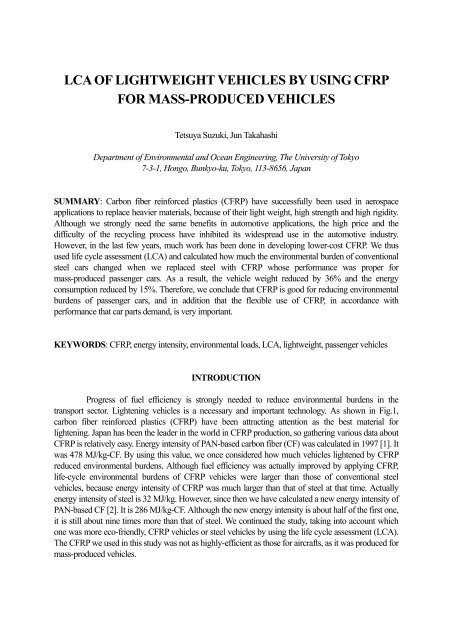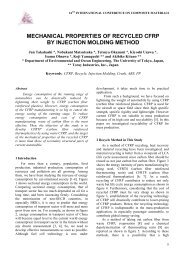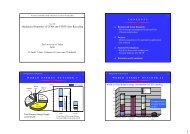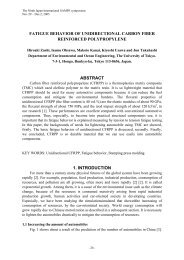lca of lightweight vehicles by using cfrp for mass ... - Takahashi
lca of lightweight vehicles by using cfrp for mass ... - Takahashi
lca of lightweight vehicles by using cfrp for mass ... - Takahashi
Create successful ePaper yourself
Turn your PDF publications into a flip-book with our unique Google optimized e-Paper software.
LCA OF LIGHTWEIGHT VEHICLES BY USING CFRPFOR MASS-PRODUCED VEHICLESTetsuya Suzuki, Jun <strong>Takahashi</strong>Department <strong>of</strong> Environmental and Ocean Engineering, The University <strong>of</strong> Tokyo7-3-1, Hongo, Bunkyo-ku, Tokyo, 113-8656, JapanSUMMARY: Carbon fiber rein<strong>for</strong>ced plastics (CFRP) have successfully been used in aerospaceapplications to replace heavier materials, because <strong>of</strong> their light weight, high strength and high rigidity.Although we strongly need the same benefits in automotive applications, the high price and thedifficulty <strong>of</strong> the recycling process have inhibited its widespread use in the automotive industry.However, in the last few years, much work has been done in developing lower-cost CFRP. We thusused life cycle assessment (LCA) and calculated how much the environmental burden <strong>of</strong> conventionalsteel cars changed when we replaced steel with CFRP whose per<strong>for</strong>mance was proper <strong>for</strong><strong>mass</strong>-produced passenger cars. As a result, the vehicle weight reduced <strong>by</strong> 36% and the energyconsumption reduced <strong>by</strong> 15%. There<strong>for</strong>e, we conclude that CFRP is good <strong>for</strong> reducing environmentalburdens <strong>of</strong> passenger cars, and in addition that the flexible use <strong>of</strong> CFRP, in accordance withper<strong>for</strong>mance that car parts demand, is very important.KEYWORDS: CFRP, energy intensity, environmental loads, LCA, <strong>lightweight</strong>, passenger <strong>vehicles</strong>INTRODUCTIONProgress <strong>of</strong> fuel efficiency is strongly needed to reduce environmental burdens in thetransport sector. Lightening <strong>vehicles</strong> is a necessary and important technology. As shown in Fig.1,carbon fiber rein<strong>for</strong>ced plastics (CFRP) have been attracting attention as the best material <strong>for</strong>lightening. Japan has been the leader in the world in CFRP production, so gathering various data aboutCFRP is relatively easy. Energy intensity <strong>of</strong> PAN-based carbon fiber (CF) was calculated in 1997 [1]. Itwas 478 MJ/kg-CF. By <strong>using</strong> this value, we once considered how much <strong>vehicles</strong> lightened <strong>by</strong> CFRPreduced environmental burdens. Although fuel efficiency was actually improved <strong>by</strong> applying CFRP,life-cycle environmental burdens <strong>of</strong> CFRP <strong>vehicles</strong> were larger than those <strong>of</strong> conventional steel<strong>vehicles</strong>, because energy intensity <strong>of</strong> CFRP was much larger than that <strong>of</strong> steel at that time. Actuallyenergy intensity <strong>of</strong> steel is 32 MJ/kg. However, since then we have calculated a new energy intensity <strong>of</strong>PAN-based CF [2]. It is 286 MJ/kg-CF. Although the new energy intensity is about half <strong>of</strong> the first one,it is still about nine times more than that <strong>of</strong> steel. We continued the study, taking into account whichone was more eco-friendly, CFRP <strong>vehicles</strong> or steel <strong>vehicles</strong> <strong>by</strong> <strong>using</strong> the life cycle assessment (LCA).The CFRP we used in this study was not as highly-efficient as those <strong>for</strong> aircrafts, as it was produced <strong>for</strong><strong>mass</strong>-produced <strong>vehicles</strong>.
INVENTORY ANALYISISPreset definition <strong>of</strong> LCA(1) Goal <strong>of</strong> the studyTo compare the life cycle environmental burden <strong>of</strong> a CFRP vehicle with that <strong>of</strong> a conventionalsteel vehicle.(2) Products to be studiedUsing statistics and catalogues from 2002, we set the specifications <strong>of</strong> the target car as a four-doorsedan with the following features: front-placed gasoline engine, front-wheel drive, and automatictransmission. The weight was 1380 kg, and the engine displacement was 2000 cc.(3) Functional unit and reference flowFunctional unit is “91,720 km”, and a car that fulfills this condition is the reference flow.(4) System boundariesThree stages: Material production, vehicle production, use(5) Elements <strong>of</strong> environmental burdensEnergy consumption and CO2 emission are mostly independent <strong>of</strong> place and time. This fact is veryuseful <strong>for</strong> conducting an LCI. In addition, the tendency <strong>of</strong> energy consumption and CO2 emission arequite similar. We, thus, only calculated the energy consumption in this study.Energy intensity <strong>of</strong> CFRP <strong>for</strong> <strong>mass</strong>-produced <strong>vehicles</strong>We used two types <strong>of</strong> CFRP in accordance with parts requirements. The first type wasthermoplastic CFRP, which was used <strong>for</strong> the bodies, because they need good rigidity. The fiber volumefraction was 30%, and the matrix was polypropylene (PP), which is thermoplastic. The weightreduction potential <strong>of</strong> the CFRPP was 70% compared with steel on a specific rigidity basis. Energyintensity <strong>of</strong> carbon fiber (CF) and PP is 286 MJ/kg and 24 MJ/kg respectively (Table 1). Weight ratiobetween CF and PP was 0.462 : 0.538. Molding method is pre<strong>for</strong>m matched die, and its energyintensity is 10 MJ/kg. There<strong>for</strong>e the energy intensity <strong>of</strong> the CFRP was 155 MJ/kg.The second type was thermosetting CFRP, which was used <strong>for</strong> the chassis, because they needgood strength. The fiber volume fraction was 60%, and the matrix was epoxy (EP), which isthermosetting. The weight reduction potential <strong>of</strong> the CFREP was 70% compared with steel on aspecific strength basis. Energy intensity <strong>of</strong> EP is 76 MJ/kg. Weight ratio between CF and EP was0.692 : 0.308. Molding method is resin transfer molding, and its energy intensity is 13 MJ/kg.There<strong>for</strong>e the energy intensity <strong>of</strong> the CFRP was 234 MJ/kg.Material production stageWe set the specification <strong>of</strong> the target <strong>vehicles</strong> as a four-door, sedan, gasoline engine, frontengine and front-wheel drive, and automatic transmission from statistics in 2002. Vehicle weight was1,380 kg, and engine displacement was 2,000 cc. In the case <strong>of</strong> steel <strong>vehicles</strong>, energy consumption <strong>for</strong>material production was 86,774 MJ. Next, in the case <strong>of</strong> CFRP <strong>vehicles</strong>, we considered how much wecould lighten parts. We assumed a weight reduction ratio as follows; body and interior and exteriorequipment were lightened <strong>by</strong> 60% due to replacing steel with CFRPP, engine system and driving andsteering system were lightened <strong>by</strong> 30% and 5% respectively due to the secondary miniaturization,electric system, liquid and others did not lighten. Consequently steel and aluminum decreased 785 kgand 12 kg respectively, and CFRPP and CFREP increased 208 kg and 84 kg respectively. The totalvehicle weight came to 881 kg and the weight reduction ratio was 36% (Table 2). Energy consumption<strong>for</strong> material production increased <strong>by</strong> 42,096 MJ compared with steel <strong>vehicles</strong> when yields <strong>of</strong> steel,aluminum, and CFRP were 61%, 64%, 60% respectively. As a result, the value <strong>of</strong> CFRP <strong>vehicles</strong> was128,870 MJ.Vehicle production stageWe set the energy consumption <strong>for</strong> vehicle production <strong>of</strong> steel <strong>vehicles</strong> as 21,406 MJ based
2. METI, Global warming program, “Report <strong>of</strong> Research and development on carbon fiberrein<strong>for</strong>ced plastic <strong>for</strong> lightening automobiles”, 2004, pp. 205-206.3. Atsushi Funazaki, Katsunori Taneda, “A study <strong>of</strong> Inventories <strong>for</strong> Automobile LCA (1) -Petroleum fuel Models and Inventories <strong>of</strong> Petroleum fuel Production -”, JARI Research Journal,Vol.21, No.12, November, 1999, pp. 58-65Specific strength (σf/ρ)50454035302520151050Steel (1470MPa)Steel (780MPa)Steel (440MPa)Steel (270MPa)CFRTS (For airplanes)CFRTS (Rapid Molding)TitaniumGFRPAlminumVf=0.10.00 0.05 0.10 0.15 0.20 0.25Specific rigidity ( 3 E/ρ)MagnesiumFig. 1 Specific rigidity and specific strength <strong>of</strong>several materialsFuel efficiency (L/km)0.20.160.120.080.040y = 6E-05x + 0.0174R 2 = 0.83870 500 1000 1500 2000 2500Vehicle weight (kg)Vf=0.5CFRTPTable 1 Energy intensity <strong>of</strong> materialsEnergy intensity [MJ/kg]Steel 32CF 286CFRPP *1 155CFREP *2 234*1: Vf = 30%, *2: Vf = 60%Table 2 Parts weight be<strong>for</strong>e and after lightenedWeight Weight WeightPartsbe<strong>for</strong>e after reductionlightened lightened ratio[kg] [kg] [%]Body 475.04 202.99 57.3Interior &Exterior223.49 183.52 17.9Chassis 278.49 152.69 45.2Engine System 194.39 136.08 30.0Driving &steering system48.62 46.20 5.0Electric system 117.69 117.69 0.0Liquid, Others 42.26 42.26 0.0Total 1380.00 881.44 36.1Fig. 2 Relation between vehicle weight and realfuel efficiencyEnergy consumption (10 4 MJ)5045403530252015105037.02.18.7Steel vehicleUseVehicle productionMaterial production25.91.712.9CFRP vehicleFig. 3 Energy consumption during the life cycle







